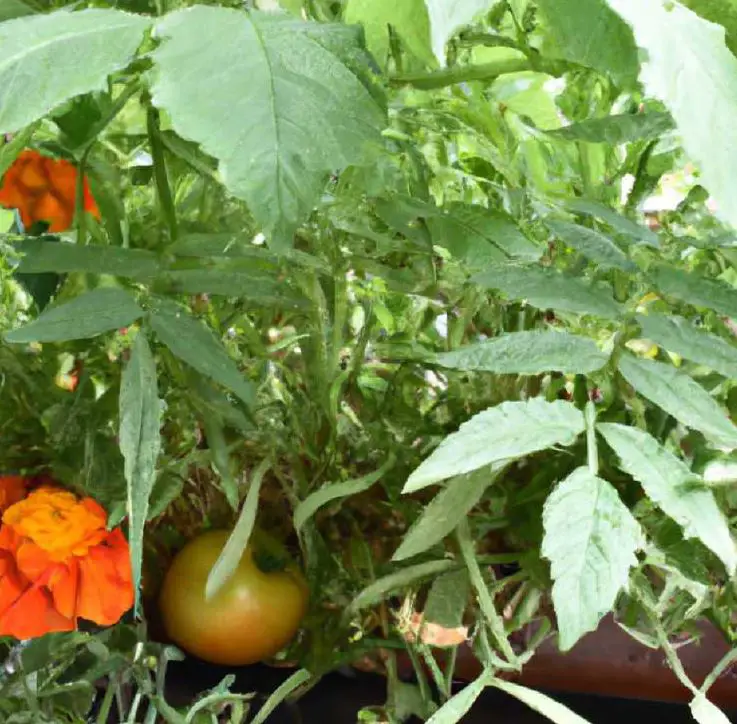In the world of gardening, there are many legends and stories that often hold grains of truth. Among these is the tale of the marigold and the tomato plant. These two species have been rumored to share a special relationship, one that can enhance the growth and health of both.
This article will delve into the marigold-tomato connection, answering questions like “do marigolds help tomato plants?” and exploring the benefits and best practices for cultivating these two popular garden plants together.
The Marvelous Marigold and Terrific Tomato Team-up
For generations, gardeners have sworn by the benefits of planting marigolds near their tomato plants. But do marigolds really help tomato plants? The answer is a resounding yes! Marigolds offer numerous benefits to tomato plants, from protecting them against pests to improving soil health.
Pest Protection
Marigolds are well known for their ability to deter a variety of common garden pests. These vibrant flowers emit a strong odor that many insects find repulsive, making them a natural and chemical-free form of pest control.
Do marigolds keep tomato worms away?
Tomato worms, also known as tomato hornworms, are a common and destructive pest that can decimate a tomato crop. Marigolds are effective in keeping these voracious eaters away, thanks to their strong scent. Planting marigolds around your tomato plants creates a barrier that tomato worms are reluctant to cross.
Are marigolds good for tomato plants?
Not only do marigolds help protect tomato plants from pests, but they also provide additional benefits. Marigolds can improve soil health by attracting beneficial insects like ladybugs and lacewings, which prey on harmful pests. Additionally, marigolds have been known to suppress nematodes – microscopic worms that can damage plant roots.
What are the best marigolds for tomatoes?
There are many types of marigolds, but not all of them offer the same benefits to tomato plants. French marigolds (Tagetes patula) are the best choice for tomato plants, as they are the most effective at repelling pests and suppressing nematodes. Make sure to choose varieties with a strong scent, as this is a key factor in their pest-deterring abilities.
Which vegetables benefit the most from marigolds?
While marigolds are particularly beneficial for tomato plants, they can also help other vegetables in your garden. Vegetables such as beans, cucumbers, and eggplants can also benefit from marigolds’ pest-repelling properties. Moreover, marigolds can be planted alongside other flowers and herbs to create a diverse and healthy garden ecosystem.
The Secret to Growing Tomatoes: Beyond Marigolds
Marigolds are just one piece of the puzzle when it comes to growing a successful tomato crop. Here are a few other tips to help you achieve a bountiful harvest:
Why put Epsom salt on tomato plants?
Epsom salt, a natural source of magnesium, can help tomato plants grow healthier and produce more fruit. Magnesium is essential for photosynthesis, and a lack of it can lead to reduced yields and weak plants. Simply dissolve a tablespoon of Epsom salt in a gallon of water and spray it on your tomato plants every two weeks.
What is the secret to growing tomatoes?
The secret to growing tomatoes is understanding their needs and providing the right conditions for them to thrive. This includes proper watering, fertilization, pruning, and pest control, as well as ensuring that your plants receive enough sunlight. By addressing these factors and incorporating marigolds into your garden, you can greatly increase your chances of a successful tomato harvest.
What should you not plant near tomatoes?
While marigolds and tomatoes make great companions in the garden, there are some plants that should not be placed near tomato plants. These include:
- Potatoes
Both tomatoes and potatoes are susceptible to the same diseases, such as blight. Planting them close together increases the risk of these diseases spreading between the plants.
- Cabbage family
Plants in the cabbage family (broccoli, cauliflower, kale, etc.) can attract pests that also enjoy feasting on tomato plants. Keep these plants separate to minimize pest problems.
- Corn
Corn and tomatoes share a common enemy: the tomato fruitworm, which also happens to be the corn earworm. Planting these two crops together could lead to increased pest pressure.
- Walnut trees
Walnut trees produce a substance called juglone, which can be toxic to tomato plants. Avoid planting tomatoes near walnut trees or in areas where walnut trees have been removed recently.
Frequently Asked Questions
By now, you should have a better understanding of the relationship between marigolds and tomato plants. To wrap things up, let’s revisit the frequently asked questions and provide a quick summary of what we’ve learned:
Yes, marigolds can help keep tomato worms away due to their strong scent.
Yes, marigolds can provide pest protection and improve soil health, benefiting tomato plants.
French marigolds (Tagetes patula) are the best choice for tomatoes because of their strong scent and effectiveness against pests and nematodes.
Besides tomatoes, vegetables like beans, cucumbers, and eggplants can benefit from marigolds’ pest-repelling properties.
Epsom salt, a natural source of magnesium, can help improve tomato plant health and boost fruit production.
The secret to growing tomatoes is understanding their needs and providing the right conditions for them to thrive, including proper watering, fertilization, pruning, pest control, and sunlight.
Avoid planting potatoes, cabbage family plants, corn, and walnut trees near tomatoes to minimize the risk of disease and pests.
By incorporating marigolds into your garden and following these tips, you can create a beautiful and bountiful tomato harvest.
Conclusion
In conclusion, the age-old gardening wisdom that marigolds help tomato plants holds true. These vibrant flowers provide an array of benefits, from natural pest control to improved soil health. By planting marigolds alongside your tomatoes and other vegetables, you can create a diverse and thriving garden ecosystem.
Furthermore, understanding the specific needs of tomato plants and providing the right conditions for growth will ensure a successful and bountiful harvest. So go ahead, add some marigolds to your garden, and watch as this dynamic duo works together to create a vibrant, healthy, and fruitful garden for you to enjoy.
Auto Amazon Links: No products found.
Perfect Plants Christmas Tree Saver 8oz. | Easy Use Xmas Tree Preserver Food | Have Healthy Green Christmas Trees All Holiday Season
$13.99 (as of January 3, 2026 15:01 GMT +00:00 - More info- Product prices and availability are accurate as of the date/time indicated and are subject to change. Any price and availability information displayed on [relevant Amazon Site(s), as applicable] at the time of purchase will apply to the purchase of this product.
VISTARAFT 47 Inch Long Christmas Tree Watering Funnel, Christmas Tree Watering System Device Long Tree Watering Waterer Spout for Indoor Outdoor Xmas Tree - Red
Now retrieving the price.
(as of January 3, 2026 15:01 GMT +00:00 - More info- Product prices and availability are accurate as of the date/time indicated and are subject to change. Any price and availability information displayed on [relevant Amazon Site(s), as applicable] at the time of purchase will apply to the purchase of this product.
HoHoHoH2o Automatic Christmas Tree Watering System Device, Santa’s Tree Helper Keeps Your Christmas Tree Healthy and Fresh, Refillable 2.5 gallons Capacity Box - Silver/Festive
$84.95 (as of January 3, 2026 15:01 GMT +00:00 - More info- Product prices and availability are accurate as of the date/time indicated and are subject to change. Any price and availability information displayed on [relevant Amazon Site(s), as applicable] at the time of purchase will apply to the purchase of this product.
Rocky Mountain Goods Christmas Tree Food - 8 oz Tree Preservative - Reduce Needle Drop - Greener Scent - Fir, Pine, Spruce Trees - Extend Tree Life
$9.95 (as of January 3, 2026 15:01 GMT +00:00 - More info- Product prices and availability are accurate as of the date/time indicated and are subject to change. Any price and availability information displayed on [relevant Amazon Site(s), as applicable] at the time of purchase will apply to the purchase of this product.
FirEver Pure Christmas Tree Food | Preserver Additive & Season Extender for Live Xmas Trees | Keep It Green, Reduce Needle-Drop | Miracle Freshness (8 oz)
$16.66 (as of January 3, 2026 15:01 GMT +00:00 - More info- Product prices and availability are accurate as of the date/time indicated and are subject to change. Any price and availability information displayed on [relevant Amazon Site(s), as applicable] at the time of purchase will apply to the purchase of this product.
Snow Joe Premium Enviro Blend Ice Melt, Green-Coated Deicer Crystals, 50 lb - Safer Melter for Vegetation, Concrete & Metals w/ Anti-Corrosion Calcium Magnesium Acetate
$32.97 (as of December 31, 2025 15:15 GMT +00:00 - More info- Product prices and availability are accurate as of the date/time indicated and are subject to change. Any price and availability information displayed on [relevant Amazon Site(s), as applicable] at the time of purchase will apply to the purchase of this product.
OLANLY Dog Door Mat for Muddy Paws 30x20, Absorbs Moisture and Dirt, Absorbent Non-Slip Washable Doormat, Quick Dry Chenille Mud Mat for Dogs, Entry Indoor Entryway Carpet for Inside Floor, Grey
$9.49 (as of December 31, 2025 15:15 GMT +00:00 - More info- Product prices and availability are accurate as of the date/time indicated and are subject to change. Any price and availability information displayed on [relevant Amazon Site(s), as applicable] at the time of purchase will apply to the purchase of this product.
TERRO Ant Killer Bait Stations T300B - Liquid Bait to Eliminate Ants - Bait System - 12 Count Stations for Effective Indoor Ant Control
$10.88 (as of December 31, 2025 15:15 GMT +00:00 - More info- Product prices and availability are accurate as of the date/time indicated and are subject to change. Any price and availability information displayed on [relevant Amazon Site(s), as applicable] at the time of purchase will apply to the purchase of this product.
Zevo Flying Insect Trap Official Refill Cartridges - Fits Both Zevo Trap & MAX Indoor Fly Trap - Authentic Trap+Lock Technology to Catch Gnats, House & Fruit Flys (4 Official Refill Cartridges)
$14.97 (as of December 31, 2025 15:15 GMT +00:00 - More info- Product prices and availability are accurate as of the date/time indicated and are subject to change. Any price and availability information displayed on [relevant Amazon Site(s), as applicable] at the time of purchase will apply to the purchase of this product.
Advion Cockroach Gel Bait, 4 Tubes x 30-Grams, 1 Plunger and 2 Tips, German Roach Insect Pest Control, Indoor and Outdoor Use, Roach Killer Gel for American, German and Other Major Cockroach Species
$25.94 (as of December 31, 2025 15:15 GMT +00:00 - More info- Product prices and availability are accurate as of the date/time indicated and are subject to change. Any price and availability information displayed on [relevant Amazon Site(s), as applicable] at the time of purchase will apply to the purchase of this product.











